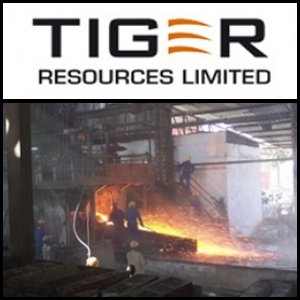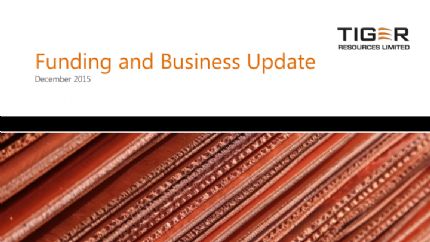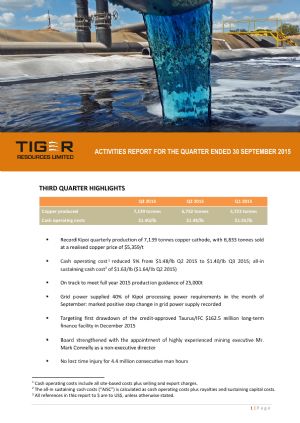 Kipoi Ore Reserves Increase to 689,000 Tonnes of Copper
Kipoi Ore Reserves Increase to 689,000 Tonnes of Copper
Perth, April 16, 2015 AEST (ABN Newswire) - Tiger Resources Limited ( ASX:TGS) (
ASX:TGS) ( TRSDF:OTCMKTS) is pleased to announce that Ore Reserves for Stage 2 of its Kipoi Copper Project in the Democratic Republic of Congo have increased to 689,000 tonnes of copper.
TRSDF:OTCMKTS) is pleased to announce that Ore Reserves for Stage 2 of its Kipoi Copper Project in the Democratic Republic of Congo have increased to 689,000 tonnes of copper.
The ore reserve estimate for Stage 2 at Kipoi increased by 23,000 tonnes from 666,000 tonnes as at 31 December 2013 to 689,000 tonnes as at 31 December 2014. The updated Kipoi Mineral Resource and Ore Reserve estimate undertaken by Cube Consulting Pty Ltd ("Cube") incorporates mining depletion to 31 December 2014. Tiger produced 13,557 tonnes of copper cathode and 16,222 tonnes of copper in concentrate at Kipoi in 2014.
HIGHLIGHTS
Kipoi Mineral Resource
- Decreased by 4.3% to 938,000 tonnes of copper, predominantly as a result of ore processed through the HMS and SXEW operations
Kipoi Stage 2 SXEW Ore Reserves
- Increased by 3.5% to 689,000 tonnes of copper
The increase in the Kipoi Central Stage 2 Ore Reserve estimate is the result of a revision of long term copper price to US$3.15/lb, increase in metallurgical recovery and lower processing cost following completion of successful metallurgical test work.
The increase in the Kileba Ore Reserve estimate is the result of a revision in the projected long term copper price to US$3.15/lb, increase in metallurgical recovery and lower processing cost.
The increase in the Kipoi North Ore Reserve estimate is the result of a revision in the projected long term copper price to US$3.15/lb, increase in metallurgical recovery and lower processing cost.
Lower processing costs for Kipoi Central, Kileba and Kipoi North are the result of the formalisation of the Megatron Energy Efficiency Project and a reduction in the long term sulphuric acid price. The ore reserves stated in Table B in link below have been generated using the following data:
- US$3.15/lb copper price used for estimation of the cut-off grades
- Mining via open pit methods using the current mining costs
- Mining recoveries and dilution have been incorporated into the mineral resource model
- SXEW processing was selected as the preferred processing method
- Process recoveries were based on metallurgical test work as detailed in JORC Table 1
- Cut-off grades were estimated after consideration of non-mining, break-even copper grade taking into account metallurgical recovery, site operating costs, royalties and revenues. The pit design was based on conventional pit optimisation techniques with detailed staged and final pit designs completed
- Due consideration was given to physical constraints and statutory charges, fees, royalties and taxes
- The marketing and delivery costs for the product were incorporated into the modelling activities
- The ore reserves were reported based on mineral resources classified as Measured and Indicated within the economic pit limits above the economic cut-off grade after due consideration of costs and physical constraints.
A summary of the information used in the August 2012 Kileba Project Mineral Resource estimate is as follows:
Geology and Geological Interpretation: Mineralisation at the Kileba deposit is hosted in dolomitic siltstone and pyroclastic rocks within Upper Roan Group sedimentary rocks. It occurs as stratiform, layer-parallel structurally remobilised mineralisation in fault breccia's and veins. Sulphide copper mineralisation occurs predominantly in deformed siltstones but also extends into the adjacent dolomites and volcanic rocks. The bulk of mineralisation occurs as broad zones of malachite (supergene copper carbonate mineral) which is best developed adjacent to fractured and brecciated siltstones. Weathering of primary mineralisation has led to lateral dispersion and the formation of coherent zones of supergene mineralisation. Wireframes were generated on cross sectional interpretations based on available geology and assay data. A lower cut off of approximately 0.3% Cu was used to define mineralised envelopes. The outlines were modelled with allowance for secondary re-mobilisation of copper.
Drilling Techniques: Resource definition reverse circulation (RC) drilling was completed using a 140mm diameter bit. Diamond drilling (DD) used for resource definition included PQ, HQ and NQ diameter core using both standard and triple inner tubes.
Sampling and Sub-Sampling Techniques: RC chips were sampled at 1 metre intervals and riffle split to produce a sample of approximately 2kg to be sent to the laboratory for analysis.
Diamond core is geologically logged and sampled to geological contacts with nominal sample lengths of 1 metre or 0.5 metre depending on core diameter size with a minimum sample length of 0.3 metre. Core samples sent to the laboratory for analysis were either half core or quarter core.
Sample Analysis Method: Most drilling assay samples were submitted to ALS Chemex in Johannesburg, South Africa (ALS_JHB) for preparation and analysis.
Samples are assayed by a multi-element analytical method (ME-ICP61) with a follow up ore grade analysis for copper (Cu) and cobalt (Co) using the ME-OG62 method on all samples. The alternative ME-OG46 has been used intermittently for ore grade partial digestion analysis.
A program of external quality assurance and quality control (QA/QC) has been applied to check for contamination, accuracy and precision within the drill sampling and assaying process. The types of check samples that have been introduced into the sample stream include blank samples ("blanks"), certified reference materials ("standards"), and field duplicate samples. For the Kileba RC and DD drilling, the QAQC program consisted of insertion of a standard, a blank or a field duplicate into the sample stream. The control samples are inserted at a rate of 1:30 for each control type. This equates to a theoretical 10% rate of QA/QC control. All samples showed acceptable levels of accuracy and precision.
Estimation Methodology: The estimation of copper and cobalt in the Southern Domain was undertaken using Ordinary Kriging of 5 metre downhole composited drilling data into a three-dimensional block model of panel size 20mN x 20mE x 5mRL. A further process of Localised Uniform Conditioning (LUC) was applied to produce a model suitable for reporting above grade cut-offs and for mine planning based on a Smallest Mining Unit (SMU) size of 5m x 5m x 2.5m and a selection of grade cut-offs. The LUC has also incorporated an Information Effect correction to allow for some effect of incomplete information on the local recoverable model result.
The estimation of copper and cobalt in the Northern Domain was undertaken using Ordinary Kriging of 2.5 metre downhole composited drilling data into a three dimensional block model with a parent cell size of 10mN x 10mE x 2.5mRL.
Criteria Used for Classification: The Kileba mineralisation has demonstrated sufficient geological and grade continuity to support the definition of a Mineral Resource and classification under the JORC Code (2012 edition). Drill hole spacing and search volume were used to determine Mineral Resource classification. Blocks have been classified as Indicated or Inferred based on data spacing and using a combination of search volume and number of data used for the estimation. Indicated Mineral Resources are defined by 25m x 25m spaced drilling. Inferred Mineral Resources mainly confined to the Northern Domain are defined by data density spacing of 100m x 25m and confidence that the continuity of geology and mineralisation can be extended along strike and at depth.
The input drill data is comprehensive in its coverage of the mineralisation and does not favour or misrepresent this mineralisation.
A summary of the information used in the October 2012 Kipoi North Mineral Resource estimate is as follows:
Geology and Geological Interpretation: Mineralisation at the Kipoi North deposit is hosted within the Lower Roan (R2) sedimentary rocks. It is predominantly secondary stratabound mineralisation concentrated in the DStrat, RSF, and RSC units. The bulk of mineralisation occurs as malachite (supergene copper carbonate mineral) which is best developed as thin layer parallel veins, as infill within dissolution vughs and as fracture fill. Weathering of primary mineralisation has led to lateral dispersion and the formation of coherent zones of supergene mineralisation. The mineralised wireframes were generated on cross sectional interpretations based on available geology and assay data. A lower cut off of approximately 0.2% Cu was used to define mineralised envelopes. The outlines were modelled with allowance for secondary re-mobilisation of copper.
Drilling Techniques: Resource definition reverse circulation (RC) drilling was completed using a 140mm diameter bit. Diamond drilling (DD) used for resource definition included PQ, HQ and NQ diameter core using both standard and triple inner tubes.
Sampling and Sub-Sampling Techniques: RC chips were sampled at 1 metre intervals and riffle split to produce a sample of approximately 2kg to be sent to the laboratory for analysis.
Diamond core is geologically logged and sampled to geological contacts with nominal sample lengths of 1 metre or 0.5 metre depending on core diameter size with a minimum sample length of 0.3 metre. Core samples sent to the laboratory for analysis were either half core or quarter core.
Sample Analysis Method: Most drilling assay samples were submitted to ALS Chemex in Johannesburg, South Africa (ALS_JHB) for preparation and analysis.
Samples are assayed by a multi-element analytical method (ME-ICP61) with a follow up ore grade analysis for copper (Cu) and cobalt (Co) using the ME-OG62 method on all samples. The alternative ME-OG46 has been used intermittently for ore grade partial digestion analysis.
A program of external quality assurance and quality control (QA/QC) has been applied to check for contamination, accuracy and precision within the drill sampling and assaying process. For the Kipoi North RC and DD drilling, the QAQC program consisted of insertion of a standard, a blank or a field duplicate into the sample stream. The control samples are inserted at a rate of 1:30 for each control type. This equates to a theoretical 10% rate of QA/QC control. All samples showed acceptable levels of accuracy and precision.
Estimation Methodology: The deposit was interpolated using Ordinary Kriging of 5 metre downhole composited drilling data into a three dimensional block model of panel size 15(Y)m x 25(X)m x 5(Z)m. A further process of Local Uniform Conditioning (LUC) was applied to produce a model suitable for reporting above grade cut-offs and for mine planning based on an SMU size of 5(Y)m x 5(X)m x 2.5(Z)m and a selection of grade cut-offs. The LUC has also incorporated an Information Effect correction to allow for some effect of incomplete information on the local recoverable model result.
Criteria Used for Classification: The Kipoi North mineralisation has demonstrated sufficient geological and grade continuity to support the definition of a Mineral Resource and classification under the JORC Code (2012 edition). Drill hole spacing and search volume were used to determine Mineral Resource classification. Blocks have been classified as Indicated or Inferred based on data spacing and using a combination of search volume and number of data used for the estimation. Indicated Mineral Resources are defined by 25m x 25m spaced drilling. Inferred Mineral Resources Inferred Mineral Resources are defined by data density greater than 25m x 25m spaced drilling and confidence that the continuity of geology and mineralisation can be extended along strike and at depth.
The input drill data is comprehensive in its coverage of the mineralisation and does not favour or misrepresent this mineralisation.
BACKGROUND
The Kipoi Project covers an area of 55 square km and is located 75km north-north-west of the city of Lubumbashi in the Katanga Province of the DRC. The project contains a 12km sequence of mineralised Roan sediments that host at least five known deposits: Kipoi Central, Kipoi North, Kileba, Judeira and Kaminafitwe.
The Company has reported JORC-compliant resources at four of the deposits: Kipoi Central, Kipoi North, Kileba and Judeira. The principal deposit is Kipoi Central, which contains a zone of high grade copper mineralisation within a much larger, lower grade global resource. Production targets are underpinned by estimated Ore Reserves which have been prepared by competent persons in accordance with the requirements of the JORC Code.
Tiger commenced production from the first phase of its Stage 2 SXEW plant in May 2014 and achieved nameplate capacity of 25,000 tonnes of copper cathode per annum from the first phase in September 2014. The company completed the transition to a pure cathode producer in September 2014 on cessation of the Stage 1 heavy media separation plant. The feasibility study (FS) for Stage 2 has confirmed the operation as a low-cost, high-margin project capable of producing 532,100 tonnes of copper cathode over 11 years at a production rate of 50,000 tonnes of copper cathode per annum, processing ore reserves from the Kipoi Central, Kileba and Kipoi North deposits and reject floats, slimes and medium grade ore stockpiles from the Stage 1 HMS operation.
It is envisaged that ore from Judeira and other deposits within the Kipoi Project area, and within the nearby 100%-owned Lupoto Project, will also be processed during the Stage 2 operations, providing additional returns and increasing the ore reserves available as feedstock to the Stage 2 Kipoi SXEW plant. Increased resources from these deposits will potentially increase the mine life and/or the annual plant throughput.
To view all figures and resource data, please visit:
http://media.abnnewswire.net/media/en/docs/ASX-TGS-715918.pdf
About Tiger Resources Limited
 Tiger Resources Limited (ASX:TGS) has established itself as a producing copper/cobalt company with excellent growth potential after making the transition from an explorer. We have a highly-rated portfolio of properties, all strategically located on the world renowned Katanga Copperbelt in the Democratic Republic of the Congo (DRC), central Africa.
Tiger Resources Limited (ASX:TGS) has established itself as a producing copper/cobalt company with excellent growth potential after making the transition from an explorer. We have a highly-rated portfolio of properties, all strategically located on the world renowned Katanga Copperbelt in the Democratic Republic of the Congo (DRC), central Africa.
![abnnewswire.com]()
Related Companies
Social Media
Share this Article

 ASX:TGS) (
ASX:TGS) ( TRSDF:OTCMKTS) is pleased to announce that Ore Reserves for Stage 2 of its Kipoi Copper Project in the Democratic Republic of Congo have increased to 689,000 tonnes of copper.
TRSDF:OTCMKTS) is pleased to announce that Ore Reserves for Stage 2 of its Kipoi Copper Project in the Democratic Republic of Congo have increased to 689,000 tonnes of copper. Tiger Resources Limited (ASX:TGS) has established itself as a producing copper/cobalt company with excellent growth potential after making the transition from an explorer. We have a highly-rated portfolio of properties, all strategically located on the world renowned Katanga Copperbelt in the Democratic Republic of the Congo (DRC), central Africa.
Tiger Resources Limited (ASX:TGS) has established itself as a producing copper/cobalt company with excellent growth potential after making the transition from an explorer. We have a highly-rated portfolio of properties, all strategically located on the world renowned Katanga Copperbelt in the Democratic Republic of the Congo (DRC), central Africa.






